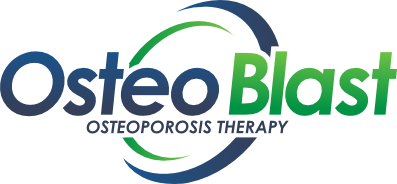Osteoporosis is a condition that occurs when our bones lose their density and become more porous and brittle. “Osteoporosis” literally means “porous bones.”
If you were to look at bones in the body from the inside out, you wouldn’t see 100% dense bone. Like pictured, our bones have regions of higher density as well as areas of lower density that have a “spongy” appearance. These characteristics allow bones to be strong yet light.
What is Osteoporosis?

It might seem strange, but bones are tissues that are very much alive. In fact, our bones undergo a constant process of cellular turnover consisting of demineralization and remineralization. Imagine demineralization as the breakdown and “digestion” of old bone cells—also known as resorption—and remineralization as the formation and remodeling of new bone cells to take their place.
It might sound counterintuitive for our bones to break themselves down, but it’s an important function in terms of repair, growth, and remodeling.
Osteoporosis happens when this natural process is out of balance. When our bone-building cells (called osteoblasts) can’t keep up with the breakdown and resorption of existing bone cells, bone mineral density decreases and our bones get more porous.
How is Osteoporosis Diagnosed?
Bone mineral density (BMD) is the scientific measurement of bone density in humans, and it is the primary measurement that is used to define and diagnose osteoporosis.
The World Health Organization (WHO) guidelines recommend that doctors measure BMD at specific sites such as the femur (leg bone) as well as the low back and in the wrist. Given these recommendations, it is estimated that as many as 10.2 million adults in the US have osteoporosis, and 43.4 million adults have low BMD that isn’t low enough yet to qualify as osteoporosis (1).
Unfortunately, many people don’t know they are osteoporotic until after they’ve broken a bone since we can’t consciously feel or tell how dense or porous our bones are. In order to know your BMD, you will need a bone scan. The gold standard for BMD tests is dual energy X-ray absorptiometry (DXA). To learn more about DXA bone density tests, click here.
Osteoporosis Risk Factors
Risk factors for the development of any disease can be thought of as those you can change (modifiable) and those you cannot (unmodifiable).
Unmodifiable Risk Factors (2)
- Age – As age increases, especially over 65 years old, the risk for the development of osteoporosis increases.
- Race – White or Asian ancestry places a patient at an increased risk for the development of osteoporosis.
- Sex – Females are significantly more likely to develop osteoporosis than men.
- Weight – People with a lower body-mass index are at a higher risk of developing osteoporosis.
- Family History – Having an immediate family member diagnosed with osteoporosis increases your likelihood of developing it as well.
Modifiable Risk Factors
- Low calcium intake – Calcium is an essential mineral for bone development. Lifelong lack of calcium intake increases the risk of osteoporosis.
- Low protein intake – A low protein diet, even after controlling for overall weight, is an independent risk factor for developing osteoporotic fractures.
- Corticosteroid use – Steroid use inhibits the bone rebuilding process and can lead to osteoporosis.
- Tobacco use – Smoking inhibits the bone’s natural healing process and is associated with the development of osteoporosis.
- Sedentary lifestyle – Patients who spend significant amounts of time sitting or inactive have a much higher risk for osteoporosis than people who are active and routinely exercise.
Osteoporosis and Fractures
The main complication of osteoporosis is an increased risk for fractures, especially fractures from activities that wouldn’t usually cause problems (known as “fragility fractures”).
Spine Fractures
The most common fracture associated with osteoporosis is a spine fracture. While these do not commonly cause nerve or spinal cord damage, they can be extremely painful and lead to the need for narcotic pain medicine, immobilization, and even surgery.
Because of these significant complications, research has shown that a patient’s risk of death increases over four-fold after sustaining a compression fracture (3).
Wrist Fractures
Wrist fractures are extremely common in elderly patients, accounting for almost 20% of all fractures suffered by elderly patients. They are significant because they can often be the first sign of osteoporosis.
By sustaining a wrist fracture, a patient increases their chances of suffering a hip or spine fracture by two- to four-fold (4). Because of this, it is a good idea for osteoporosis to be thoroughly screened in elderly patients who have sustained wrist fractures.
Hip Fractures
Hip fractures are perhaps the most feared and significant complication of osteoporosis. They can be significant events that cause deteriorating health in patients who were otherwise doing well.
One study found that after sustaining a hip fracture, patients suffered a 30% mortality rate over the next six months (5). This highlights how potentially dangerous osteoporosis and “fragility fractures” can be, especially for elderly adults.
Is Osteoporosis Preventable?
As mentioned above, osteoporosis has several modifiable risk factors. This is great news! Here are three lifestyle changes you can make to decrease your risk for osteoporosis by improving bone density:
- Quit smoking. If you smoke, the single most important thing you can do to improve your bone health is quit right away. This will decrease your risk of osteoporosis significantly.
- Vitamin D and Calcium. Both vitamin D and calcium are important parts of maintaining bone health. Current recommendations are 800 international units (IU) of vitamin D daily and 1,200 mg of calcium daily for elderly patients.
- Exercise Regularly. Activity and regular exercise not only help to build strong bones but improves balance and coordination, which also aids in the prevention of falls, which cause “fragility fractures.”
OsteoBlast: Osteoporosis Prevention & Reversal Program

At Pacific Coast Sports Medicine, we have developed a comprehensive osteoporosis rehabilitation program called OsteoBlast that utilizes innovative exercise machines, like the bioDensity, Power Plate, and Kore Balance, to promote healthy bone regeneration safely and effectively. No drugs!
If you’re looking to reduce risk of fracture by improving balance and bone density, contact our OsteoBlast Program Director, Dr. Starler.
References
1. World Health Organization. WHO Scientific Group on the Assessment of Osteoporosis At Primary Health. World Health. 2007; May (May 2004):1-13.
2. Hannan MT, Felson DT, Dawson-Hughes B, et al. Risk Factors for Longitudinal Bone Loss in Elderly Men and Women: The Framingham Osteoporosis Study. J Bone Miner Res. 2010;15(4):710-720.
3. Jalava T, Sarna S, Pylkkänen L, et al. Association Between Vertebral Fracture and Increased Mortality in Osteoporotic Patients. J Bone Miner Res. 2003;18(7):1254-1260.
4. Bogoch ER, Elliot-Gibson V, Escott BG, Beaton DE. The Osteoporosis Needs of Patients With Wrist Fracture. J Orthop Trauma. 2008;22(8 Suppl):S73-S78.
5. Goldacre MJ, Roberts SE, Yeates D. Mortality after admission to hospital with fractured neck of femur: database study. BMJ. 2002;325(7369):868-869.
